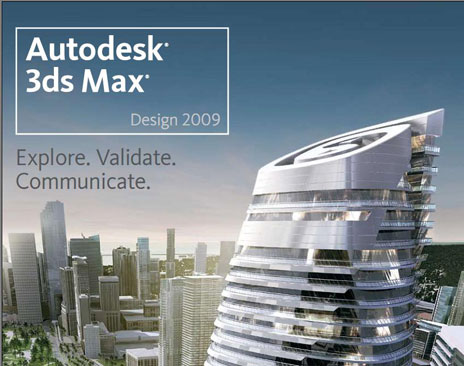Create stunning 3D in less time with Autodesk® 3ds Max® software. This full-featured 3D modeling, animation, rendering, and effects solution is used to produce top-selling games and award-winning film and video content. Those looking to quickly and efficiently generate convincing characters, seamless CG effects, or jaw-dropping games will want to explore this latest release of the software.

Highlights
Achieve stunning results in less time with Autodesk® 3ds Max® software. Autodesk 3ds Max 2009 introduces time-saving new animation and mapping workflow tools, groundbreaking new rendering technologies, and significantly improved 3ds Max interoperability and compatibility with other industry-standard products such as Autodesk® Maya®.
New rendering technologies include Reveal™ rendering—a toolset for both iterative workflows and dramatically faster, finished renderings—and ProMaterials™, a material library for simulating real-world surfaces. Rig your quadrupeds faster and more efficiently with the new Biped workflow. “Hands like feet” is just one of a number of new and improved character animation and mapping features that streamline potentially labor-intensive processes. Plus, the release gives you improved OBJ and Autodesk® FBX® import and export, for vastly enhanced 3ds Max interoperability with Autodesk® Mudbox™, Maya, Autodesk® MotionBuilder™, and other third-party applications.
Key New Features and Enhancements
Reveal Rendering
The Reveal rendering system, new in 3ds Max 2009, gives you the precise control you need to quickly refine your renders. Choose to render your entire scene minus a specific object; or render a single object, or even a specific region of the Framebuffer. The rendered image Framebuffer now contains a simplified set of tools to quickly validate changes in a render by optionally filtering out objects, regions and/or processes in order to balance quality, speed, and completeness.
Biped Enhancements
The addition of a new Biped workflow means you can now have your Biped character’s hands behave like feet with regards to the ground plane. This new feature dramatically simplifies the number of steps needed to create quadruped animations. Autodesk 3ds Max also delivers support for rotating Biped objects around the Working Pivot, as well as the Pick Pivot, which facilitates the creation of certain kinds of dramatic character performances—for example, a character falling to the ground.
Improved Support for OBJ and FBX
Greater OBJ translation fidelity, along with more export options, make it easier for you to move data between 3ds Max and Mudbox—as well as other digital sculpting applications. Take advantage of new export presets, additional geometry options (including hidden splines/lines), and new optimize options that give you reduced file sizes for improved performance. Game artists will particularly enjoy the improved texture map handling and improved Mudbox import information with regard to face counts per object. 3ds Max also delivers improved FBX memory management and new import options that support interoperability between 3ds Max and other products such as Maya and MotionBuilder
Streamlined UV Texture Editing
Autodesk 3ds Max continues to lead the industry in intelligent, easy-to-use mapping tools. The new spline mapping feature can be used to map tubular and spline-like objects such as mapping a road onto terrain. Additionally, improvements have been made to the Relax and Pelt workflows that streamline UVW unwrapping—enabling you to achieve your desired results in fewer steps.
.NET Support in the SDK
Support for .NET in 3ds Max allows you to use Microsoft’s efficient, high-level user interface APIs to extend the software. The 3ds Max SDK ships with sample .NET code and documentation showing developers how they can take advantage of this powerful set of development tools.
ProMaterials
A new library of easy-to-use, physically-based materials for mental ray® has been added to 3ds Max. These enable you to quickly create commonly used building and design surfaces, such as professional wall paint–with glossy or matte finishes—solid glass, and concrete.
Photometric Lighting Enhancements
Autodesk 3ds Max delivers support for new types of area lights (circular, cylindrical), photometric web previews in the Browse dialog and Light user interface, and improved near-field photometry quality and spot distribution. Plus, distribution types can now support any emitting shape and you can have your light shapes appear as objects in the rendered image.








There`s No Place Like 127.0.0.1
|